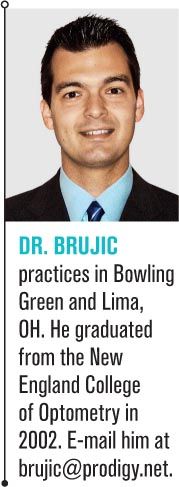Where do you fall on the optometry spectrum?
When it comes to optometry, innovation, and pushing for better care for your patients, where are you? We have met practitioners on all sides of the spectrum in many areas of optometry.

We all live on a spectrum. We are either in the middle or at one extreme or another. Politically, some of us do our part by voting when it comes time, others push legislation and get involved with candidates. Some people golf twice a summer, while others golf twice a week.
Regardless of the topic, you are on the spectrum-not involved, somewhat involved, or all in.
When it comes to optometry, innovation, and pushing for better care for your patients, where are you? We have met practitioners on all sides of the spectrum in many areas of optometry. Look at the list below and ask yourself where you stand on the spectrum and if that is where you want to be when you leave your office for the last time.
Related: What is the public image of optometry?

Organized optometry
Some love what optometry is for them as a job-but that is it. They do not pay dues to any optometry political organizations that drive our profession forward, and they clock in and out at the same time every day.
These are the individuals who see continuing education as a nuisance because it conflicts with something else that they do on the far end of the spectrum. With regard to the other end of the spectrum, there are those who devote years of their lives and sacrifice time and money to be part of political action or leadership for our profession.
Related: AOA addresses concerns of the profession
Regardless of where you stand with our great American Optometric Association (AOA), it drives our profession. Spending one hour inside the annual House of Delegates will show you how serious these people are.
We have rubbed shoulders with these people in the committees of which we are a part, and until you serve as an advocate at the local, state, or national level, you will never know how extreme these people have gone in order to provide you the opportunities in our profession that we all know.
For the middle-of-the-roaders or people who do not have opportunity to serve (yet), may we suggest that you do your part by contributing to your state and national PAC? If you cannot give your time, at least give your money to keep our profession moving forward. And make sure that if you are not on the extreme end that you continually thank those who are.
Next: Dry eye treatment
Dry eye treatment
Dry eye has turned. There are those who do not agree and think that the use of artificial tears is still a viable treatment for our dry eye patients. Others have come to realize that dry eye has a cause and thus the effects (corneal staining, decreased tear volume, tear osmolarity, etc.) bring about the symptoms of dry eye.
Ergo, these practitioners look for the underlying cause and utilize the latest prescription drugs to help the progressive disease when it is inflammatory in nature. For other patients, they may utilize thermal pulsation and heat in conjunction with blink therapy to decrease the progression of the disease.
Symptoms are not the key for these extremers-they see that slowing the progression of the disease state as their primary motive.
From our experience with practitioners, we see the 80/20 rule come in. We see that 20 percent of the ODs out there prescribe well beyond 80 percent of the dry eye pharmaceuticals. Are you still in the dark ages, or are you aggressive?
Related: Why the tear film matters
Next: Innovation
Innovation
If innovation is a bell shaped curve with aggressive practitioners and innovators on one end and low-cost, lack of innovation on the other, where do you lie? Whenever innovation and care come up, we need to understand that our patients are unaware of innovation and why things might cost more.
Unless properly educated, they will always choose lower cost. In an effort to satisfy the desires of its patients, one extreme will provide its services at the lowest cost and will have the lowest-cost products. The problem with this approach is that it lacks the ability to innovate.
Related: Earning a spot on the medical team
Others are innovating in their practices and educating their patients as to why. They purchase OCT technology, bring in single-use lenses at a high percentage, utilize non-glare treatments for all their patients, and sell nutracuticals in office.
Although they may lose some patients because they are no longer the cheapest in town, they gain a patient base that is passionate about their eyesight and prevention. Remember, your team and your patients rarely pull you to be more innovative-they will always tug you in the path of least resistance. It is up to those who want to be unique, different, and interested in providing state-of-the-art care to pull toward innovation.
Whether you like it or not, you’re on the curve. Are you pushing, pulling, or holding your ground? We challenge you to push yourself to the next level, to innovate, to contribute, and be a better you.
Newsletter
Want more insights like this? Subscribe to Optometry Times and get clinical pearls and practice tips delivered straight to your inbox.